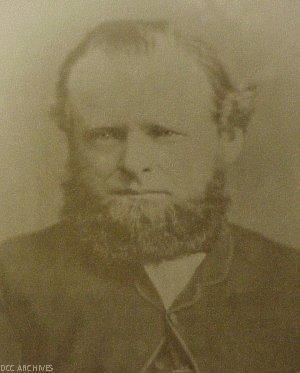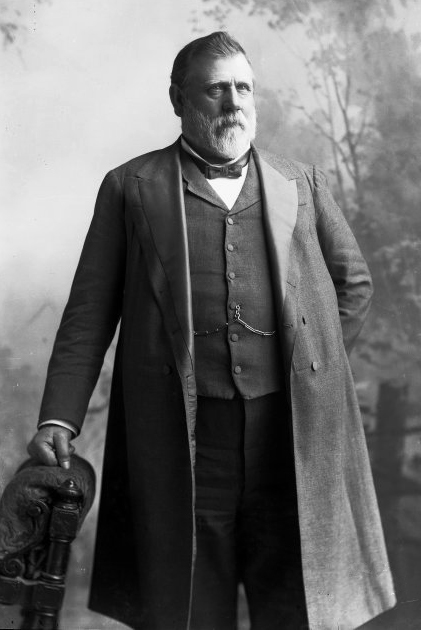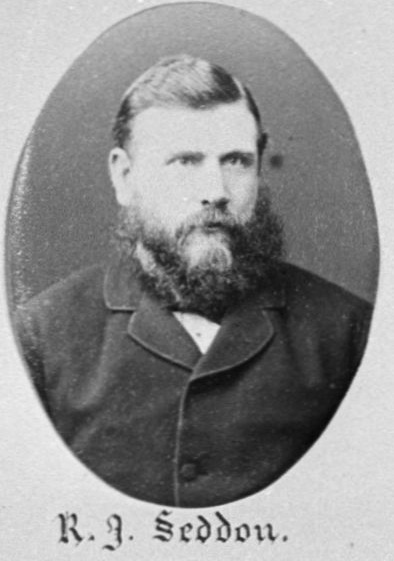|
William Reynolds (New Zealand Politician)
William Hunter Reynolds (1 May 1822 – 1 April 1899) was a 19th-century businessman and Member of Parliament in Dunedin, Otago region, New Zealand. He was a cabinet minister. He is the only person who held membership on the Otago Provincial Council over the entire course of its existence (1853–1876), was Speaker of the council for three years, and was a member of the council's executive eight times. Early life Reynolds was involved in shipping by trade, initially in partnership with his brother-in-law James Macandrew who had married his sister Elizabeth Hunter Reynolds. Reynolds himself married Rachel Pinkerton in 1856 and they raised nine children together. Political career In the inaugural 1853 provincial council elections, Reynolds was one of six representatives for the Dunedin Country electorate in the Otago Provincial Council (1853–1855). In the 1855 election, he successfully stood for the Town of Dunedin electorate. He represented that electorate, from the ... [...More Info...] [...Related Items...] OR: [Wikipedia] [Google] [Baidu] |
Dunedin And Suburbs South
Dunedin and Suburbs South was a parliamentary electorate in the city of Dunedin in Otago, New Zealand from 1862 to 1866. From 1863 it was a multi-member electorate. History During the second session (from 7 July to 15 September 1862) of the 3rd Parliament, the Representation Act 1862 was passed. The Act stipulated that the two-member City of Dunedin electorate was to be abolished in 1863 and replaced with Dunedin and Suburbs North and Dunedin and Suburbs South. Clause 9 of the Act read: The existing two members of the City of Dunedin shall thenceforth, as long as they retain their seats, be respectively members of the district of Dunedin and suburbs North and Dunedin and suburbs South, in manner following, that is to say, the earliest elected member shall be a member for the district of Dunedin and suburbs North, and the last elected member shall be a member for the district of Dunedin and suburbs South. The first elected member was Thomas Dick, but he resigned from the Ci ... [...More Info...] [...Related Items...] OR: [Wikipedia] [Google] [Baidu] |
3rd New Zealand Parliament
The 3rd New Zealand Parliament was a term of the Parliament of New Zealand. Elections for this term were held between 12 December 1860 and 28 March 1861 in 43 electorates to elect 53 MPs. Two electorates were added to this during this term, Gold Fields District (overlaid over existing Otago electorates) and a new Dunedin electorate created by splitting the existing City of Dunedin into Dunedin and Suburbs North and Dunedin and Suburbs South, increasing the number of MPs to 57. During the term of this Parliament, six Ministries were in power. Historical context The third Parliament opened on 3 June 1861 (after a postponement from the previously announced date of 30 May 1861), following New Zealand's 1860–1861 election. It was the second Parliament under which New Zealand had responsible government, meaning that unlike the first Parliament, the Cabinet was chosen (although not officially appointed) by Parliament rather than by the Governor. Political parties had not been est ... [...More Info...] [...Related Items...] OR: [Wikipedia] [Google] [Baidu] |
Nathaniel Wales (architect)
Nathaniel Young Armstrong Wales (1832 – 3 November 1903) was a 19th-century architect, Member of Parliament, and Mayor in Dunedin, Otago, New Zealand. Biography Wales was born in Northumberland, England. He trained as an architect in Jedburgh, Scotland. He joined the Victorian gold rush in its early days and then migrated to Dunedin in 1861. He was employed by the architect William Mason and in 1871 joined him as a partner in the firm. He represented the City of Dunedin electorate from to 1875, when he retired. He was later Mayor of Dunedin from 1895 to 1896. Coincidentally, Wales' partner Mason had held the same position during the 1860s. Notable designs One of his notable designs is his own house at 38 Belgrave Crescent, which was built from stones quarried on the site. He designed the New Zealand Insurance Company Building, which is located on the corner of Queens Gardens and Crawford Street, and which is registered as a Category I heritage by Heritage New Zealan ... [...More Info...] [...Related Items...] OR: [Wikipedia] [Google] [Baidu] |
John Bathgate
John Bathgate (10 August 1809 – 21 September 1886) was a 19th-century New Zealand politician, and Minister of Justice and Commissioner of Stamps from 1872 to 1874. Life Bathgate was born in Edinburgh in 1809. While a boy, the family moved to Peebles where his father had a teaching position. After school, he went to West Scotland to act as a private secretary and then to Edinburgh for an apprenticeship. At age 33, he married Miss Anderson. After her death, he married Miss McLaren. He had three sons, nine daughters, and (at the time of his death) 27 grandchildren. In his early 30s, Bathgate became town clerk in Peebles. Bathgate was the principal promoter of the Peebles Railway. He was chosen by English backers as manager for the new Bank of Otago and emigrated to New Zealand within months. There was a great depression during the mid-1860s and Bathgate had lost money to the Commercial Banking Co., and had allowed the Southland Provincial Council to overdraw well beyond ... [...More Info...] [...Related Items...] OR: [Wikipedia] [Google] [Baidu] |
Thomas Birch (New Zealand Politician)
Thomas Birch (1825 – 12 March 1880) was a 19th-century Member of Parliament in Dunedin Dunedin ( ; mi, Ōtepoti) is the second-largest city in the South Island of New Zealand (after Christchurch), and the principal city of the Otago region. Its name comes from , the Scottish Gaelic name for Edinburgh, the capital of Scotland. Th ..., Otago, New Zealand. He represented the City of Dunedin electorate from to 1870, when he retired. He was the third Mayor of Dunedin. References 1825 births 1880 deaths Mayors of Dunedin New Zealand MPs for Dunedin electorates Members of the New Zealand House of Representatives 19th-century New Zealand politicians {{NewZealand-mayor-stub ... [...More Info...] [...Related Items...] OR: [Wikipedia] [Google] [Baidu] |
Thomas Dick (politician)
Thomas Dick (13 August 1823 – 5 February 1900) was a 19th-century New Zealand politician. Originally a merchant, he worked in London and then represented his firm on Saint Helena for seven years. From there, he was sent to Dunedin as the company's representative; he emigrated with an extended family. He soon became involved in politics and was Superintendent of Otago Province from 1865 until 1867. Over a period of 24 years, he represented various Dunedin electorates in Parliament and was Colonial Secretary (1880–1884), Minister of Justice from 1881 to 1882, and Minister of Education from 1881 to 1884. A deeply religious man, he was involved in many church affairs. He was one of the founders of Hanover Street Baptist Church; the building is now classified as Category I by Heritage New Zealand. Early life Dick was born in Edinburgh, the son of Thomas Dick and Marjorie Dick (née Sherriff). The family moved to London, but he was sent back to Edinburgh for his education. He ... [...More Info...] [...Related Items...] OR: [Wikipedia] [Google] [Baidu] |
James Paterson (New Zealand Politician)
James Paterson (1807 – 29 July 1886) was a 19th-century Member of Parliament in Otago, New Zealand. He was a cabinet minister, and on the Legislative Council. Paterson was born in Edinburgh in 1807. He lived in British Guiana for 14 years and by the early 1850s, he had returned to Edinburgh. He met George Ross, one of Dunedin's first settlers, who had come back to Edinburgh to have a ship built for him. Paterson emigrated to Dunedin on that ship, the ''Clutha'', and reached Dunedin on 12 February 1854. He was a merchant in Dunedin and went into partnership with George Hepburn, and together they bought out the business of James Macandrew. Paterson was first elected onto the Otago Provincial Council for the Town of Dunedin electorate on 2 October 1861 and served for the remainder of the third council, and for all of the fourth council until 10 January 1867. For three separate periods between April 1862 and April 1865, he was a member of the executive council. When Edwa ... [...More Info...] [...Related Items...] OR: [Wikipedia] [Google] [Baidu] |
Edward Cephas John Stevens
Edward Cephas John Stevens (18 October 1837 – 6 June 1915) was a New Zealand politician in provincial government in Canterbury, and a member of both the lower and upper houses of parliament. A businessman, he controlled the Christchurch '' Press'' for many decades. He was instrumental in introducing cricket to Canterbury and one of his dealings as a land and estate agent resulted in the creation of Lancaster Park. Early life Stevens was born at Salford in the county of Oxfordshire, England. He was the youngest son of Reverend William Everest Stevens (the local rector), and his wife, Mary James. He was educated at Marlborough College and at the Royal Agricultural College in Cirencester. At age 21, Stevens emigrated to New Zealand. Among the passengers were the surveyor John Henry Whitcombe (known by his middle name Henry) with his wife, Maria Whitcombe (née North), and their family. Several sources say that they arrived in Lyttelton on 20 September 1858 on the ''Zea ... [...More Info...] [...Related Items...] OR: [Wikipedia] [Google] [Baidu] |
New Zealand Liberal Party
The New Zealand Liberal Party was the first organised political party in New Zealand. It governed from 1891 until 1912. The Liberal strategy was to create a large class of small land-owning farmers who supported Liberal ideals, by buying large tracts of Māori land and selling it to small farmers on credit. The Liberal Government also established the basis of the later welfare state, with old age pensions, developed a system for settling industrial disputes, which was accepted by both employers and trade unions. In 1893 it extended voting rights to women, making New Zealand the first country in the world to enact universal adult suffrage. New Zealand gained international attention for the Liberal reforms, especially how the state regulated labour relations. It was innovating in the areas of maximum hour regulations and compulsory arbitration procedures. Under the Liberal administration the country also became the first to implement a minimum wage and to give women the rig ... [...More Info...] [...Related Items...] OR: [Wikipedia] [Google] [Baidu] |
Thomas Kelly (New Zealand Politician)
Thomas Kelly (1830 – 20 September 1921) was a 19th-century Member of Parliament in Taranaki, New Zealand. He represented the Town of New Plymouth electorate from to 1879, and then the (renamed) New Plymouth electorate from to 1884, when he was defeated. He then became a member of the Legislative Council from 1892 to 1913. In 1893 Kelly, a new councillor was at the centre of a drama that led to the passing of the Women's suffrage bill into law. Premier Seddon had expected to stop the bill in the upper house, but found that one more vote was needed. Kelly had left himself paired in favour of the measure, but Seddon obtained his consent by wire to change his vote. Seddon's manipulation so incensed two opposition councillors William Reynolds and Edward Cephas John Stevens Edward Cephas John Stevens (18 October 1837 – 6 June 1915) was a New Zealand politician in provincial government in Canterbury, and a member of both the lower and upper houses of parlia ... [...More Info...] [...Related Items...] OR: [Wikipedia] [Google] [Baidu] |
Richard Seddon
Richard John Seddon (22 June 1845 – 10 June 1906) was a New Zealand politician who served as the 15th premier (prime minister) of New Zealand from 1893 until his death. In office for thirteen years, he is to date New Zealand's longest-serving head of government. Seddon was born in Eccleston near St Helens, Lancashire, in England. He arrived in New Zealand in 1866 to join an uncle in the West Coast goldfields. His prominence in local politics gained him a seat in the House of Representatives in 1879. Seddon became a key member of the Liberal Party under the leadership of John Ballance, but differed from him greatly due to his conservativism clashing with Ballance's progressivism. When the Liberal Government came to power in 1891 Seddon was appointed to several portfolios, including Minister of Public Works. His natural leadership and confrontational manner, however, led him to quickly rise to become the man who would control the fate of the Liberal Party itself. Sedd ... [...More Info...] [...Related Items...] OR: [Wikipedia] [Google] [Baidu] |
Women's Suffrage In New Zealand
Women's suffrage in New Zealand was an important political issue in the late nineteenth century. In early colonial New Zealand, as in European societies, women were excluded from any involvement in politics. Public opinion began to change in the latter half of the nineteenth century and after years of effort by women's suffrage campaigners, led by Kate Sheppard, New Zealand became the first nation in the world in which all women had the right to vote in parliamentary elections. The Electoral Bill granting women the franchise was given Royal Assent by Governor Lord Glasgow on 19 September 1893. Women voted for the first time in the election held on 28 November 1893 (elections for the Māori electorates were held on 20 December). Also in 1893, Elizabeth Yates became Mayor of Onehunga, the first time such a post had been held by a woman anywhere in the British Empire. In the 21st century there are more eligible female voters than male, and women also vote at a higher rate t ... [...More Info...] [...Related Items...] OR: [Wikipedia] [Google] [Baidu] |





